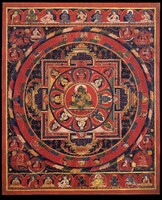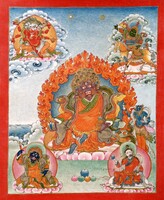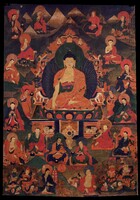Black Hayagriva - Two Great Paintings
 The two images depicted on this page are of the Tantric Buddhist meditational deity Black Hayagriva. They are from two different 'Revealed Treasure' traditions of the Nyingma School of Tibetan Buddhism. The image on the left belongs to the discoveries of Nyangral Nyima Ozer and the image on the right belongs to the discoveries of Guru Chowang. In both paintings, below the top register, there is a single figure of a Karmapa Lama identifying both paintings as having been commissioned by a follower of the Karma Kagyu Tradition. The deity Black Hayagriva is primarily found and practiced in the Nyingma and Karma Kagyu Schools of Tibetan Buddhism, although sometimes found in the Gelug School as well.
The two images depicted on this page are of the Tantric Buddhist meditational deity Black Hayagriva. They are from two different 'Revealed Treasure' traditions of the Nyingma School of Tibetan Buddhism. The image on the left belongs to the discoveries of Nyangral Nyima Ozer and the image on the right belongs to the discoveries of Guru Chowang. In both paintings, below the top register, there is a single figure of a Karmapa Lama identifying both paintings as having been commissioned by a follower of the Karma Kagyu Tradition. The deity Black Hayagriva is primarily found and practiced in the Nyingma and Karma Kagyu Schools of Tibetan Buddhism, although sometimes found in the Gelug School as well.
The painting on the left has had some conservation work but is otherwise unrestored. The painting on the right has had restoration work done in the way of colour fill, line re-enforcing and adding. Despite the age, damage over time and restoration, both compositions are wonderful examples of 15th and 16th century Tibetan painting. They are filled with exquisite details, patterns and shading. The faces of the secondary figures in both paintings are exceptionally expressive.

















